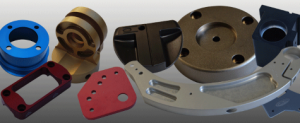MIL-A-8625F Type III, Class 1 or 2
 Precision Hard Coat Anodizing is different than conventional anodizing. Lowering the temperature and increasing the current density produces a thicker and more compact layer on the surface of the metal. This process is ideal for parts that need extra protection under extreme conditions.
Precision Hard Coat Anodizing is different than conventional anodizing. Lowering the temperature and increasing the current density produces a thicker and more compact layer on the surface of the metal. This process is ideal for parts that need extra protection under extreme conditions.
Hard Coat Anodizing penetrates the metal as much as it builds up on the surface. The term “thickness” includes penetration and build up. A typical hard anodized application will increase in diameter by .002” (50 microns) – .001 penetration and .001 build up – and produce a hardness of 60 to 65 Rockwell on the C scale.
Hardcoat can cost more than sulfuric acid anodize but is usually less than chromic acid anodize. In comparison to other wear-resistant coatings applied to aluminum, it is generally much more economical.
Note: The Hard Coat Anodize process is not compatible with Aluminum Alloy 2024.
